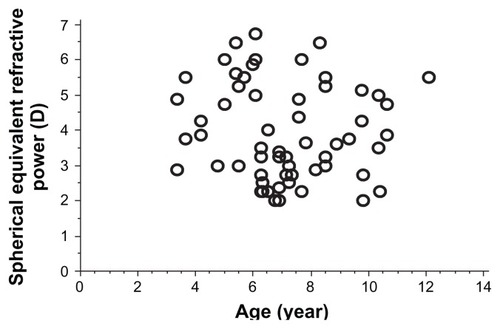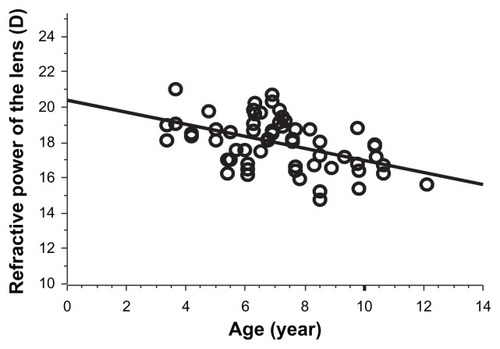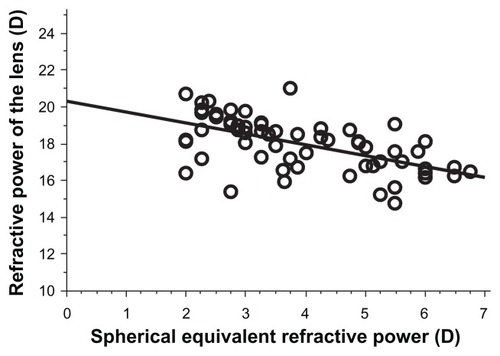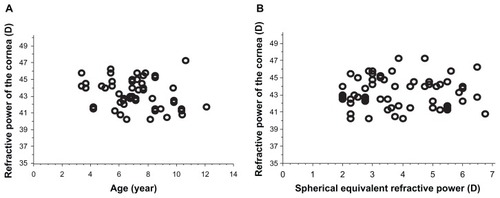Abstract
Objectives
To evaluate the contribution of axial length, and lenticular and corneal power to the spherical equivalent refractive error in children with hyperopia between 3 and 13 years of age, using noncontact optical biometry.
Methods
There were 62 children between 3 and 13 years of age with hyperopia (+2 diopters [D] or more) who underwent automated refraction measurement with cycloplegia, to measure spherical equivalent refractive error and corneal power. Axial length was measured using an optic biometer that does not require contact with the cornea. The refractive power of the lens was calculated using the Sanders-Retzlaff-Kraff formula. Single regression analysis was used to evaluate the correlation among the optical parameters.
Results
There was a significant positive correlation between age and axial length (P = 0.0014); however, the degree of hyperopia did not decrease with aging (P = 0.59). There was a significant negative correlation between age and the refractive power of the lens (P = 0.0001) but not that of the cornea (P = 0.43). A significant negative correlation was observed between the degree of hyperopia and lenticular power (P < 0.0001).
Conclusion
Although this study is small scale and cross sectional, the analysis, using noncontact biometry, showed that lenticular power was negatively correlated with refractive error and age, indicating that lower lens power may contribute to the degree of hyperopia.
Keywords:
Introduction
It is recognized that hyperopia in infants is associated with the pathogenesis of accommodative esotropia and amblyopia, but these conditions are preventable with the use of spectacles to correct refractive error. Atkinson et alCitation1 reported that infants who wore spectacles had better visual acuity and a lower incidence of strabismus compared with infants with uncorrected hyperopia, at 4 years of age. Hyperopia gradually develops into emmetropia throughout infancy, especially in the first years of life.Citation2–Citation5 The process of emmetropization can be considered the convergence of refractions toward a low hyperopic value, since it is reported that the average reduction in refractive error is a linear function of the initial level.Citation6 However, there is substantial variability in the extent of emmetropization in infants with hyperopia. It is reported that the most hyperopic infants, those in excess of +5 diopters (D), tend not to emmetropize effectively.Citation7 Thus, the mechanisms of emmetropization remain unclear.
The decline in hyperopia appears to be associated with increasing axial length. The cornea and lens could also be important contributors to emmetropization. The increase in axial length alone would result in an excessive shift towards myopia; however, this is offset by simultaneous changes in the lens that reduce power during infancy.Citation6 If the power of the lens and cornea were low, even if the axial length increased, very hyperopic infants would not move rapidly toward emmetropia. Although recent longitudinal studies demonstrated that the refractive power of the lens decreases with age, the role of lens power in hyperopes is still unclear.Citation8
Until now, amplitude modulation ultrasonography (A-scan) has been a conventional tool for measuring axial length and the corneal and lenticular power in infants. However, infants tend to fear the approach of the probe. The OA-1000 optical biometer (Tomey Corp, Nagoya, Japan) incorporates innovative technology to achieve high speed scanning and measurements in the depth direction (10 values in about 5 seconds) and sufficiently long scanning distance from the cornea to the retina with the interferometer. Unlike ultrasound biometry, this technique has the significant advantage of being quick and not requiring topical anesthesia for corneal applanation. Previous studies have reported that conventional ultrasound biometry resulted in a 54% measurement error in axial length.Citation9,Citation10 This noncontact technique appears to be valuable for the measurement of axial length, and corneal and lenticular power, in infants. In this study, we utilized the OA-1000 in a cross-sectional study evaluating the contribution of major ocular components, such as axial length, and corneal and lenticular power, to the degree of hyperopia of infants.
Patients and methods
Children who attended a pediatric ophthalmology clinic at the Fukui University Hospital between April 2010 and May 2012 and who received a diagnosis of hyperopia (+2 D or more) without accommodative esotropia were enrolled into this cross-sectional study. In children with bilateral hyperopia, the eye with the higher degree of hyperopia was included in this study. This study was approved by the University of Fukui Institutional Review Board. Parents provided written informed consent according to the tenets of the Declaration of Helsinki, after all procedures were explained. Children with esotropia, other ophthalmological diseases, and history of ophthalmological surgery were excluded. Other exclusion criteria included previous strabismus surgery, albinism, nystagmus, and ocular or neurologic conditions. Cycloplegic refractive errors were determined 45 minutes after instillation (twice within 5-minute intervals) of cyclopentolate 1% eyedrops. Refraction measurements were obtained using an auto ref/keratometer (TONOREF™ II; NIDEK, Gamagori, Japan). All patients were prescribed spectacles soon after hyperopia-related amblyopia was first diagnosed, and the full cylinder was always given.
Refractive errors were reported in terms of spherical equivalents. Corneal refraction (expressed in D) was also obtained from the auto ref/keratometer readings. Axial length measurements were performed by the same operator, using A-scan biometry (the Tomey OA-1000 optical biometer). The refractive power of the lens was calculated using the Sanders-Retzlaff-Kraff formula: P = A − 0.9K − 1.5R − 2.5L, where P represents the intraocular lens power for emmetropia, K represents corneal refractive power (K-reading), L is the axial length, A is the A-constant, and R represents the spherical equivalent refractive error. The same individual performed all measurements, using the same instruments. Univariate regression analysis was used to evaluate the correlation among the parameters. A P-value of 0.05 was accepted as statistically significant.
Results
There were 62 eyes, in 62 children with hyperopia (+2 D or more), included in the study. These children, 29 boys and 33 girls, were aged 7.14 ± 1.99 years (mean ± standard deviation) at the time of data collection. The mean spherical equivalent refractive power was +3.94 ± 1.39 D, and the average degree of astigmatism was +3.0 ± 0.52 D. The mean visual acuity was 20/25, and the axial length was 21.38 ± 0.98 mm. The mean refractive power of the lens and cornea were +17.97 ± 1.44 D and +43.30 ± 1.77 D, respectively.
Our initial analysis found a significant negative correlation between spherical equivalent refractive power and axial length (P < 0.0001) (). To determine whether axial length increases with aging, we examined the relationship between age and axial length (). A significant positive correlation was found between age and axial length (P = 0.0014). Since these results raise the possibility that increases in axial length with aging may lead to the relief of hyperopia, we assessed the relationship between age and spherical equivalent refractive power (). Hyperopia tended to decrease with aging, but we found no significant correlation (P = 0.59). Factors related to the degree of refraction, other than axial length, include refractive power of the lens or cornea. Thus we investigated the relationship between age and lenticular refractive power (). A significant negative correlation was observed between age and lenticular refractive power (P = 0.0001). Since decreases in the refractive power of the lens with aging may result in the progression of hyperopia, we examined the relationship between spherical equivalent refractive power and lenticular refractive power () and found a strong negative correlation (P < 0.0001).
Figure 1 Relationship between spherical equivalent refractive power and axial length.
Abbreviation: D, diopter.

Figure 2 Correlation between age and axial length.

Figure 3 Correlation between age and spherical equivalent refractive power.
Abbreviation: D, diopter.

Figure 4 Correlation between age and refractive power of the lens.
Abbreviation: D, diopter.

Figure 5 Correlation between spherical equivalent refractive power and lenticular power.
Abbreviation: D, diopter.

We also investigated the relationship between the refractive power of the cornea and age, and a statistically significant correlation was not seen (P = 0.43). Also, there was no correlation between spherical equivalent refractive power and the refractive power of the cornea (P = 0.77) ().
Discussion
Short axial length is an important determinant of the degree of hyperopia in children. Our data, obtained using noncontact optical biometry, showed a significant positive correlation between axial length and age. Also, a significant negative correlation between the lenticular power and age was observed. These data may imply the growth of axial length and the decreased lens power with aging, demonstrated by previous longitudinal studies.Citation8,Citation11–Citation13 Moreover, we found that there was a significant negative correlation between lenticular power and the degree of hyperopia. In cases of severe hyperopia, the extensive growth of axial length and the limited decline of lens power are required to achieve emmetropization; however, our data suggested that the lens power is lower in eyes with a high degree of hyperopia. Therefore, weak lens power, as well as the limited growth of the axial length, may contribute to the high degree of hyperopia.
In this study, we used the optical biometer OA-1000, which provides noncontact and noninvasive measurements of axial length, based on the principle of low coherence interferometry. The optical biometry technique has higher precision and resolution than conventional ultrasound biometry. Rajan et alCitation14 showed that the use of optical biometry to measure intraocular lens power improved refraction after cataract surgery by 16%. The measurement using ultrasound biometry resulted in a mean shortening of the eye length. This error in measurement is thought to be due to the compression of the surface of the cornea by the probe.Citation15 Moreover, measurements can be done without contact with the cornea, minimizing the risk of infection and increasing the effectiveness in those children who fear the approach of the probe and become uncooperative. Therefore the use of the optical biometry is considered valuable for estimating axial length in children.
We focused on the children who had hyperopia and set a spherical equivalent refraction cutoff. A lack of decline in the refractive error with aging could be due to the spherical equivalent refraction cutoff, since the emmetropizing children, in whom there was a reduction in hyperopia, might drop out of the sample of children at older ages. Actually, a significant correlation between age and refractive error was not found in our study. This result may be also explained by the decrease in lenticular power with aging, leading to a shift toward hyperopia. Mutti et alCitation11 showed that an increase in axial length leads to a decrease in refractive power (shift to myopia) and lens power (shift to hyperopia), in infants aged 3 and 9 months, and this correlation between increased axial length and decreased optical power was proposed as the “give and take” involved in emmetropization. Our data on children between 3 and 13 years of age showed a significant negative correlation between lenticular power and age. Consequently, it is possible that the myopic shift caused by increases in axial length is partially compensated by increased hyperopia that is caused by a reduction in lenticular power. This issue has been extensively studied using the Collaborative Longitudinal Evaluation of Ethnicity and Refractive Error (CLEERE)Citation16 and the Sharable Content Object Reference Model (SCORM) data.Citation8 In the SCORM study, 1747 children were classified into five groups: persistent hyperopia, emmetropizing hyperopia, persistent emmetropia, newly developed myopia, or persistent myopia. The lens power similarly decreased with aging in all groups except for the newly developed myopes, who showed significantly greater decrease in lens power. Therefore, it is likely that the decline of spherical equivalent refraction is not a specific physiological change in eyes with hyperopia. Axial elongation may remain the major biometric cause of myopia and emmetropization. Nevertheless, the loss of lens power needs to be assessed in more detail, since the regulation of the change in the lens power in relation to axial elongation or refractive change is still unclear. Further analysis of the lens power, calculated with the measurements of axial length using noncontact optical biometry, would be valuable for a more accurate investigation in a larger and longitudinal study.
Mechanisms involved in the decrease of lenticular power may involve, as observed by Zadnik et al, an actual lenticular thinning during childhood.Citation12 During the period of rapid ocular growth, a significant association between increases in the equatorial diameter of the ocular globe and that of the lens has been found.Citation6,Citation13 As this change generates a force that stretches the lens in the equatorial plane and flattens the lens during ocular growth, the dioptric power of the lens decreases rapidly in childhood.Citation6,Citation13 On the other hand, Iribarren et alCitation8 found a positive correlation between lens power and lens thickness and showed that there is a rapid loss of lens power and thickness up to the age of 10 years, with the lens slowly thickening after that age but continuing to lose power very slowly. The hyperopic shift in childhood, when the lens is increasing in thickness and curvature, is known as the lens paradox. This paradox would be resolved if increasing steepness of the gradient of refractive index leads to loss of lens power.Citation6,Citation17,Citation18 It is possible that the compaction of the prenatal lens fibers (which results in lens thinning and flattening of lens surface) during childhood steepens the gradient of refractive index, making the lens lose internal power.Citation8,Citation19
In contrast to lenticular power, corneal power was not significantly correlated with age, consistent with previous reports that corneal power does not change between 6 and 9 years of age.Citation6,Citation16 Sorsby et alCitation20 showed that corneal power declines only minimally, from approximately +43.0 D at the age of 3 years to +42.7 D at the age of 14 years. Taken together, this suggests that corneal power has little influence on spherical equivalent refractive errors in childhood.
The clarity of visual input is considered to be the major contributing factor to the control of eye growth and emmetropization.Citation6,Citation21 Several studies have provided evidence that full correction of the hyperopic refractive error with eyeglasses may hinder emmetropization.Citation4,Citation22–Citation24 According to these studies, eliminating the retinal blur with appropriate lenses could remove the stimulus for the myopic shift toward emmetropia in hyperopic children. In contrast, Demirkilinç et alCitation7 suggested that partial or full correction of hyperopia has similar effects on refractive development as in accommodative esotropia. Thus, it is possible that the way of correction for hyperopia may influence on the refractive development. In this study we excluded patients with partial optical correction of hyperopia.
In this study, we analyzed axial length and lens power in children with hyperopia, using noncontact biometry, and showed a significant negative correlation between lens power and refractive error in hyperopes, indicating that lower lens power may contribute to severe hyperopia. However, further longitudinal study is necessary to clarify whether severe hyperopes with lower lens power are slowly driven in an emmetropic direction.
Disclosure
The authors report no conflicts of interest in this work.
References
- AtkinsonJBraddickORobierBTwo infant vision screening programmes: prediction and prevention of strabismus and amblyopia from photo- and videorefractive screeningEye (Lond)199610Pt 21891988776448
- AtkinsonJAnkerSBobierWNormal emmetropization in infants with spectacle correction for hyperopiaInvest Ophthalmol Vis Sci200041123726373111053269
- YahalomCTzurVBlumenfeldARefractive profile in oculocutaneous albinism and its correlation with final visual outcomeBr J Ophthalmol201296453753922133989
- IngramRMArnoldPEDallySLucasJEmmetropisation, squint, and reduced visual acuity after treatmentBr J Ophthalmol19917574144161854694
- EhrlichDLBraddickOJAtkinsonJInfant emmetropization: longitudinal changes in refraction components from nine to twenty months of ageOptom Vis Sci199774108228439383797
- BrownNPKoretzJFBronAJThe development and maintenance of emmetropiaEye (Lond)199913Pt 1839210396390
- Demirkilinç BilerEUretmenOKöseSThe effect of optical correction on refractive development in children with accommodative esotropiaJ AAPOS201014430531020736122
- IribarrenRMorganIGChanYHLinXSawSMChanges in lens power in Singapore Chinese children during refractive developmentInvest Ophthalmol Vis Sci20125395124513022786912
- NorrbySSources of error in intraocular lens power calculationJ Cataract Refract Surg200834336837618299059
- OlsenTSources of error in intraocular lens power calculationJ Cataract Refract Surg19921821251291564648
- MuttiDOMitchellGLJonesLAAxial growth and changes in lenticular and corneal power during emmetropization in infantsInvest Ophthalmol Vis Sci20054693074308016123404
- ZadnikKMuttiDOFusaroREAdamsAJLongitudinal evidence of crystalline lens thinning in childrenInvest Ophthalmol Vis Sci1995368158115877601639
- MuttiDOZadnikKFusaroREFriedmanNESholtzRIAdamsAJOptical and structural development of the crystalline lens in childhoodInvest Ophthalmol Vis Sci19983911201339430553
- RajanMSKeilhornIBellJAPartial coherence laser interferometry vs conventional ultrasound biometry in intraocular lens power calculationsEye (Lond)200216555255612194067
- FindlODrexlerWMenapaceRHeinzlHHitzenbergerCKFercherAFImproved prediction of intraocular lens power using partial coherence interferometryJ Cataract Refract Surg200127686186711408132
- ZadnikKMannyREYuJACollaborative Longitudinal Evaluation of Ethnicity and Refractive Error (CLEERE) Study GroupOcular component data in schoolchildren as a function of age and genderOptom Vis Sci200380322623612637834
- DubbelmanMVan der HeijdeGLThe shape of the aging human lens: curvature, equivalent refractive index and the lens paradoxVision Res200141141867187711369049
- HashemiHIribarrenRMorganIGKhabazkhoobMMohammadKFotouhiAIncreased hyperopia with ageing based on cycloplegic refractions in adults: the Tehran Eye StudyBr J Ophthalmol2010941202319692387
- AugusteynRCOn the growth and internal structure of the human lensExp Eye Res201090664365420171212
- SorsbyABenjaminBSheridanMStoneJLearyGARefraction and its components during the growth of the eye from the age of threeMemo Med Res Counc1961301Special16713915328
- FlitcroftDIA model of the contribution of oculomotor and optical factors to emmetropization and myopiaVision Res19983819286928799797983
- BakerJDParksMMEarly-onset accommodative esotropiaAm J Ophthalmol198090111187395949
- FriedburgDKlöppelKPEarly correction of hyperopia and astigmatism in children leads to better development of visual acuityKlin Monbl Augenheilkd199620912124 [German.]8965472
- TroiloDNeonatal eye growth and emmetropisation–a literature reviewEye (Lond)19926Pt 21541601624037
